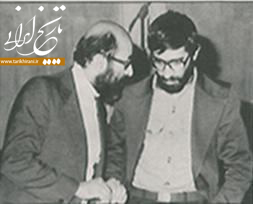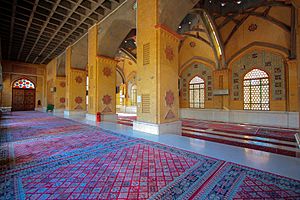Mir-Hossein Mousavi facts for kids
Quick facts for kids
Mir-Hossein Mousavi
|
|||||||||||||||||||||||||||||||||||||||||||||||||||||||||||||||||
|---|---|---|---|---|---|---|---|---|---|---|---|---|---|---|---|---|---|---|---|---|---|---|---|---|---|---|---|---|---|---|---|---|---|---|---|---|---|---|---|---|---|---|---|---|---|---|---|---|---|---|---|---|---|---|---|---|---|---|---|---|---|---|---|---|---|
|
میرحسین موسوی
|
|||||||||||||||||||||||||||||||||||||||||||||||||||||||||||||||||
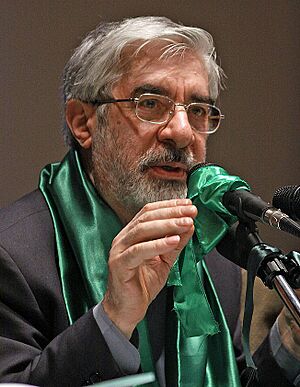 |
|||||||||||||||||||||||||||||||||||||||||||||||||||||||||||||||||
| 45th Prime Minister of Iran | |||||||||||||||||||||||||||||||||||||||||||||||||||||||||||||||||
| In office 29 October 1981 – 16 August 1989 |
|||||||||||||||||||||||||||||||||||||||||||||||||||||||||||||||||
| President | Ali Khamenei | ||||||||||||||||||||||||||||||||||||||||||||||||||||||||||||||||
| Preceded by | Mohammad-Reza Mahdavi Kani | ||||||||||||||||||||||||||||||||||||||||||||||||||||||||||||||||
| Succeeded by | Office abolished | ||||||||||||||||||||||||||||||||||||||||||||||||||||||||||||||||
| Minister of Foreign Affairs | |||||||||||||||||||||||||||||||||||||||||||||||||||||||||||||||||
| In office 5 July 1981 – 15 December 1981 |
|||||||||||||||||||||||||||||||||||||||||||||||||||||||||||||||||
| Prime Minister | Mohammad-Ali Rajai Mohammad-Javad Bahonar Reza Mahdavi Kani (acting) Himself |
||||||||||||||||||||||||||||||||||||||||||||||||||||||||||||||||
| Preceded by | Mohammad-Ali Rajai (acting) | ||||||||||||||||||||||||||||||||||||||||||||||||||||||||||||||||
| Succeeded by | Ali Akbar Velayati | ||||||||||||||||||||||||||||||||||||||||||||||||||||||||||||||||
| Head of Mostazafan Foundation | |||||||||||||||||||||||||||||||||||||||||||||||||||||||||||||||||
| In office 4 December 1981 – 6 September 1989 |
|||||||||||||||||||||||||||||||||||||||||||||||||||||||||||||||||
| Appointed by | Ruhollah Khomeini | ||||||||||||||||||||||||||||||||||||||||||||||||||||||||||||||||
| Preceded by | Mohammad-Ali Rajai | ||||||||||||||||||||||||||||||||||||||||||||||||||||||||||||||||
| Succeeded by | Mohsen Rafighdoost | ||||||||||||||||||||||||||||||||||||||||||||||||||||||||||||||||
| Senior Advisor to the President of Iran | |||||||||||||||||||||||||||||||||||||||||||||||||||||||||||||||||
| In office 12 October 1997 – 3 August 2005 |
|||||||||||||||||||||||||||||||||||||||||||||||||||||||||||||||||
| President | Mohammad Khatami | ||||||||||||||||||||||||||||||||||||||||||||||||||||||||||||||||
| Succeeded by | Mojtaba Samareh Hashemi | ||||||||||||||||||||||||||||||||||||||||||||||||||||||||||||||||
|
|||||||||||||||||||||||||||||||||||||||||||||||||||||||||||||||||
| Personal details | |||||||||||||||||||||||||||||||||||||||||||||||||||||||||||||||||
| Born |
Mir-Hossein Mousavi Khameneh
2 March 1942 Khameneh, Imperial State of Iran |
||||||||||||||||||||||||||||||||||||||||||||||||||||||||||||||||
| Political party | The Green Path of Hope (2009–present) | ||||||||||||||||||||||||||||||||||||||||||||||||||||||||||||||||
| Other political affiliations |
Islamic Republican Party (1979–1987) Movement of Militant Muslims (1977–1979) |
||||||||||||||||||||||||||||||||||||||||||||||||||||||||||||||||
| Spouse |
Zahra Rahnavard
(m. 1969) |
||||||||||||||||||||||||||||||||||||||||||||||||||||||||||||||||
| Children | 3 | ||||||||||||||||||||||||||||||||||||||||||||||||||||||||||||||||
| Relatives | Hossein Sharifzadegan (brother-in-law) | ||||||||||||||||||||||||||||||||||||||||||||||||||||||||||||||||
| Residences | Tehran, Iran | ||||||||||||||||||||||||||||||||||||||||||||||||||||||||||||||||
| Alma mater | National University of Tehran | ||||||||||||||||||||||||||||||||||||||||||||||||||||||||||||||||
| Occupation | Architect, educator | ||||||||||||||||||||||||||||||||||||||||||||||||||||||||||||||||
| Awards | |||||||||||||||||||||||||||||||||||||||||||||||||||||||||||||||||
| Signature |  |
||||||||||||||||||||||||||||||||||||||||||||||||||||||||||||||||
| Website | kaleme.org | ||||||||||||||||||||||||||||||||||||||||||||||||||||||||||||||||
Mir-Hossein Mousavi Khameneh (born March 2, 1942) is an Iranian politician, artist, and architect. He served as the 45th and last Prime Minister of Iran from 1981 to 1989. A prime minister is like a country's chief minister, helping the president run the government.
In 2009, he ran for president as a reformist candidate. After the election, he became a leader of the opposition during the protests that followed. Mousavi was also the head of the Iranian Academy of the Arts until 2009. He believes in making changes within Iran's laws. In 2023, he spoke out against the government and asked for a public vote to change Iran's political system.
Before becoming prime minister, Mousavi was the editor of Jomhouri-e Eslami, a newspaper for the Islamic Republican Party. He then became the Minister of Foreign Affairs. He was the last person to hold the Prime Minister position in Iran, as it was removed in 1989. After that, he mostly stayed out of public politics for 20 years. Today, Mousavi is still a member of important councils, but he has not attended their meetings for a long time. Many people see this as a sign that he does not agree with the government.
For the 2009 presidential election, Mousavi returned to politics. He ran against the president at the time, Mahmoud Ahmadinejad. Official results said he lost, but many people believed the election was unfair. This led to large protests across Iran and around the world. Even with government crackdowns, he is still seen as a leader of the Iranian Green Movement. He is currently under house arrest with his wife, Zahra Rahnavard, and another opposition figure, Mehdi Karroubi.
Contents
Early Life and Education
Mir-Hossein Mousavi was born on March 2, 1942, in Khameneh, Iran. His family came from Tabriz. His father was a tea merchant. Mousavi grew up in Khameneh and moved to Tehran in 1958 after finishing high school. He is related to Ali Khamenei, who is now the Supreme Leader of Iran.
He studied architecture at the National University of Tehran, now called Shahid Beheshti University. He earned his master's degree in architecture in 1969. He focused on traditional Iranian building styles. As a student, he was active in a student group called the Islamic association. He also had a close connection with the Freedom Movement of Iran, a political party. Many future Iranian leaders were part of this group and became his friends. Mousavi also showed his artwork under a different name, Hossein Rah'jo.
In 1969, Mousavi married Zahra Rahnavard. She was also a university student who studied sculpture. Rahnavard later became the head of Alzahra University and an adviser to former President Mohammad Khatami. They have three daughters. All of them speak Azeri, Persian, English, and Arabic.
Role in the Iranian Revolution

Mousavi and his wife were very active in the Iranian Revolution. He was even put in prison for organizing protests against the king, Mohammad Reza Pahlavi. As the revolution grew, Mousavi became more involved. He helped create a group called the Movement of Militant Muslims. Later, he joined Mohammad Beheshti, who was close to the revolution's leader, Ruhollah Khomeini.
After the king's rule ended in 1979, Mousavi helped found the Islamic Republican Party. This party helped set up the Islamic republic in Iran. He became the party's political secretary and the chief editor of its newspaper, Jomhouri-e Eslami. Because of his work, some people call him "The Architect" of the Islamic Republic.
In 1979, Khomeini appointed him to the Council of the Islamic Revolution. As a newspaper editor, he often criticized Abolhassan Banisadr, Iran's first president. In 1981, Banisadr was removed from office. On August 15, 1981, Mousavi became the foreign minister. He held this job until December 15, 1981, when he was appointed prime minister.
Serving as Prime Minister
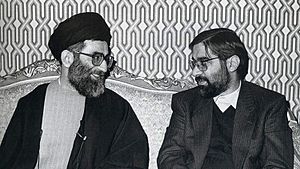
In August 1981, President Mohammad-Ali Rajai and Prime Minister Mohammad-Javad Bahonar were killed in an explosion. Ali Khamenei was then elected as the third President of Iran. Khamenei suggested Ali Akbar Velayati as his prime minister, but the parliament did not approve him. Even though Khamenei had some doubts about Mousavi, he agreed to suggest him as a compromise. On October 28, 1981, with Khomeini's approval, the parliament voted for Mousavi to become the 79th prime minister of Iran. He officially started on October 31, 1981.
Mousavi belonged to the left wing of the Islamic Republic, while Ali Khamenei belonged to the right wing. They often had disagreements during their eight years of working together. Their conflicts grew, and Mousavi resigned shortly after the Iran–Iraq War ended in 1988. However, Ruhollah Khomeini, the supreme leader, supported Mousavi and refused to accept his resignation. Khomeini generally protected Mousavi from hardliners and allowed him to manage the economy freely.
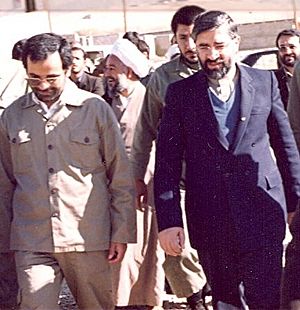
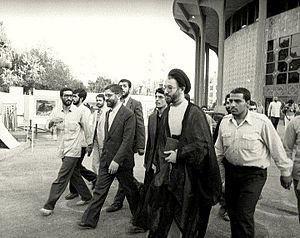
Mousavi's time as prime minister happened during the Iran–Iraq War. He helped guide the country through the war. He was praised for managing the national economy during this difficult time. He introduced a system using bonds to help share goods fairly among people during the war. Many experts praise how he handled Iran's economy and his leadership during the war. They also note his efforts to improve Iran's relationships with other countries. In 1986, Mousavi was involved in the Iran–Contra affair. This involved secret talks with the USA to help free American hostages in Lebanon. In return, Iran received American weapons and spare parts needed for the war.
A year after the Iran–Iraq War ended in 1988, Ruhollah Khomeini passed away in June 1989. Ali Khamenei was then chosen as the new Supreme Leader of Iran. After Khomeini's death, Mousavi and his allies lost their main supporter. During discussions about rebuilding the country after the war, Mousavi had strong disagreements with Ali Akbar Hashemi Rafsanjani, who was the speaker of Iran's parliament. Rafsanjani suggested that Iran accept help from Western countries for reconstruction.
On July 28, 1989, Iran's laws were changed after a national vote. One of these changes removed the position of Prime Minister. Rafsanjani was then elected as the fourth president of Iran. Mousavi's time as prime minister ended on August 3, 1989. He was not asked to join the new government and largely disappeared from public life.
Life After Politics
After Khomeini's death in 1989, Mousavi was no longer part of the government. For 20 years, he was mostly out of public view. Many people thought this showed he did not agree with the government. However, he did serve on two important government councils.
In 1989, Ali Khamenei made him a member of the Expediency Discernment Council, where he still serves. Mousavi has also been a member of the Supreme Council of Cultural Revolution since 1996. He was also a political adviser to President Akbar Hashemi Rafsanjani (1989–1997) and a senior adviser to President Mohammad Khatami (1997–2005).
During these years, he mostly left politics and went back to architecture and teaching. He became the President of the Iranian Academy of Arts. He designed the main building of the Academy. He also spent more time painting and writing poetry. He taught at Shahid Beheshti University and later at Tarbiat Modares University. His architectural works include the Kanoon-e Tohid in Tehran and the Haft-e-tir Martyr's tomb in Behesht-e Zahra. In recent years, he has been more active in painting and has shown his art in many exhibitions.
Presidential Candidacy
Before 2009
Mousavi chose not to run for president in the 1997 elections. This led reformists to support Mohammad Khatami, who was then a less known religious leader. Khatami won the election by a large margin. During Khatami's time as president, Mousavi served as his Senior Adviser.
Mousavi was considered a top candidate for the reformist group in the 2005 Iranian presidential election. However, on October 12, 2004, he decided not to run after meeting with President Mohammad Khatami and other leaders.
2009 Presidential Election
After 20 years of being out of the political spotlight, Mousavi announced on March 9, 2009, that he would run in the 2009 Iranian presidential election. He said his main goals were to create social fairness, freedom of speech, stop corruption, and help Iran's economy grow. He criticized the president at the time, Mahmoud Ahmadinejad, for how he managed the economy. On March 16, 2009, former Iranian President Khatami decided not to run and supported Mir-Hossein Mousavi instead.
His Plans
Mousavi ran as an independent candidate who believed in reform. He helped start the reformist movement in Iran, but he also shared some ideas with conservatives. Many reformist groups supported him after Khatami stepped down. Mousavi said he welcomed support from all parties. His decision to run made it harder for conservatives to fully support Mahmoud Ahmadinejad.
Plans for Iran
Mousavi often said he wanted to change the laws to allow private television stations. Currently, all Iranian TV stations are owned by the government. He also wanted the president to control law enforcement, so they would represent the people who elected the president. He said that not following Iran's rules was a big problem. He wanted to make sure laws were followed and that people were informed about government matters. He also wanted to create a free flow of information and improve the national budget. He aimed to stop the "Moral Police" and ensure women's rights.
Mousavi also said he would not stop Iran's nuclear program, stating it was for "peaceful purposes." He believed giving up the program would be a huge loss for Iran. He said that if elected, he would work to guarantee that Iran's nuclear activities would always be peaceful. On May 30, Mousavi promised to change unfair laws against women and work for their equality. He wanted to make sure women could achieve financial independence and serve in high-level government jobs.
Plans for Other Countries
Mousavi wanted to improve Iran's relationships with other countries to help the country. This included talking with U.S. President Barack Obama if Obama's actions matched his words. He also criticized Ahmadinejad's views on The Holocaust and condemned the killing of Jews during that time.
Protests After the Election
The election took place on June 12, 2009. Official results showed Ahmadinejad winning by a lot. However, Mousavi and many others believed the results were fake. They thought the Interior Minister, Sadegh Mahsouli, who was Ahmadinejad's friend, changed the votes. Mousavi claimed he won and asked his supporters to celebrate, which led to large protests.
A spokesman for Mousavi, Mohsen Makhmalbaf, said on June 19, 2009: "Previously, he was revolutionary, because everyone inside the system was a revolutionary. But now he's a reformer. Now he knows Gandhi – before he knew only Che Guevara. If we gain power through aggression we would have to keep it through aggression. That is why we're having a green revolution, defined by peace and democracy."
Because of the protests, the Supreme Leader ordered a partial recount of the votes. A council showed the recount on television, and it still showed President Ahmadinejad leading. After this, the Guardian Council confirmed the election results, saying there was no proof of problems, and closed the case.
The Green Movement Begins
The Iranian Green Movement refers to a series of actions after the 2009 Iranian presidential election. Protesters wanted Mahmoud Ahmadinejad removed from office.
Mousavi, Mehdi Karroubi, Hossein-Ali Montazeri, and Mohammad Khatami are seen as leaders of the Green Movement. "Where is my vote?" (Persian: رای من کجاست؟) was a popular slogan during the protests. People chanted this phrase in English to get international attention. The Iranian government said Ahmadinejad won by a large amount, but Mousavi and Karroubi's supporters accused the government of cheating.
After the election, Ahmadinejad and other leaders called the opposition "a pile of dust." This made the protests even bigger. Huge peaceful protests happened across the country. Even though the government banned gatherings, slowed down the internet, and censored media, hundreds of thousands of Iranians marched. Many protesters were arrested, and some were killed by police and militia forces. Neda Agha-soltan and Sohrab Aarabi were among those who died. There were also reports of abuse in prison.
Since the election, the government has made it very hard for foreign and Iranian media to get information about the opposition. So, many scenes of the protests were filmed by the people participating themselves.
Death of Mousavi's Nephew
Seyed Ali Mousavi was Mir-Hossein Mousavi's nephew. Ali Mousavi died on December 27, 2009, during the 2009 Iranian election protests. He was reportedly shot by security forces during demonstrations against Ahmadinejad's election win.
Iranian filmmaker Mohsen Makhmalbaf, who spoke for Mir-Hossein Mousavi's campaign abroad, told BBC News that Iranian secret police had called Seyed Ali Mousavi several times before he was shot, threatening him. After he died, his body was taken to a hospital, where protesters gathered outside. Security forces used tear gas to break up the protest. Later, it was found that the government had taken his body to an unknown place to try and stop further protests.
The Green Path of Hope
Mousavi and other reformist leaders are now working to spread their ideas using peaceful and legal methods. They have formed a new group called The Green Path of Hope. Political groups in Iran need permission from the Interior Ministry. Mousavi does not see the current government as legitimate, so he is unlikely to get permission. The group was called a "path" to get around this law.
The Green Path of Hope aims to continue protests against Ahmadinejad's presidency using legal and peaceful ways. They want the laws of the country to be fully followed. Mousavi said, "You can't follow some parts of the constitution and throw the rest into a bin."
Mousavi described the movement: "The Green Path of Hope is formed for the sake of people’s rightful demands and for claiming their rights... the color green is the symbol of this movement; its slogan is demanding the impeccable implementation of the constitution, and innumerable self-motivated independent societies form the body of this movement."
The movement includes many political parties, non-profit groups, and social networks. Mousavi stressed that existing, independent social networks are part of this movement. He said, "During the election, our mottos supported and remained in the framework of the constitution; today we are devoted to those slogans. We believe that if the people's demands were treated fairly, instead of being distorted by the media and linked to foreigners, and the government promoted truth by fair criticism, our mottos could satisfy the public."
The "Green Path" has six main members on its central council. These members are connected to reformist parties and social networks. The main part of the movement will be ordinary protesters. The plan is to connect existing issues in society through a social network and lead protests in a lawful way.
Arab Spring Events
After the revolutions in Tunisia and Egypt, Green Movement leaders in Iran called for protests on February 14, 2011. The government responded by putting movement leaders under house arrest. On February 14, Iranian state TV showed about 50 conservative members of parliament chanting "Death to Mousavi, death to Karroubi."
House Arrest
Mousavi and his wife, along with Mehdi Karoubi, were placed under house arrest in February 2011. This happened after they asked their supporters to protest in support of uprisings in the Arab world. On February 2, 2013, Iran's security forces arrested Mousavi's two daughters, Zahra and Nargess Mousavi, at their home. A news agency reported that they were questioned and then released the same day. After Hassan Rouhani was elected President in 2013, it was announced that Mousavi and Rahnavard would soon be freed. However, as of 2021, he was still under house arrest.
In 2019, Mousavi was given the right to leave his home once a week. Also, his close family could visit him anytime. They were also allowed to use a mobile phone and satellite television.
Political and Academic Roles
- Member of Central Campaign of Islamic Republican Party (1979–1981)
- Head of Political Office of Islamic Republican Party (1980–1981)
- Editor-in-chief of Islamic Republican (1981)
- Minister of Foreign Affairs (1981)
- President of Council of Cultural Revolution (1981)
- Prime Minister of Iran (1981–1989)
- President of Mostazafen Foundation of Islamic Revolution (1981–1989)
- President of Economy Council (1982–1989)
- Political adviser of president Hashemi Rafsanjani (1989–1997)
- Senior adviser of President Khatami (1997–2005)
- Member of Expediency Discernment Council (1989–2012)
- Member of Supreme Council of Cultural Revolution (1996–2012)
- President of Iranian Academy of Arts (2000–2009)
- Leader of Green Movement and The Green Path of Hope (2009– )
Images for kids
See also
 In Spanish: Mir-Hosein Musaví para niños
In Spanish: Mir-Hosein Musaví para niños


